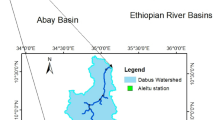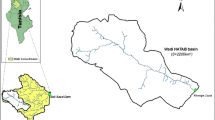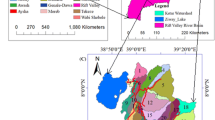Abstract
In this study, hydrological modeling of the West Rapti River, Nepal was carried out for estimation of runoff and sediment yield using the Soil and Water Assessment Tool (SWAT) model. The water balance components of the SWAT model, viz. precipitation, surface runoff, lateral flow, groundwater recharge, actual evapotranspiration and potential evapotranspiration, were studied. The SWAT model setup was carried out for simulation of discharge and sediment yield on a monthly basis for the years 2000–2013 (14 years). Calibration and validation of the model were carried out using SWAT-CUP with Sequential Uncertainty Fitting (SUFI-2) technique. The model was calibrated and validated for the years 2003–2006 and 2007–2009, respectively, using measured streamflow and rating curve generated sediment data. The model performed well for both calibration and validation periods. The model showed reliable estimates of monthly runoff (R2 = 0.96, NSE = 0.95, PBIAS = 4.7 and RSR = 0.22) and sediment yield (R2 = 0.71, NSE = 0.68, PBIAS = 15.10 and RSR = 0.57) for the calibration period. During validation period, model results were lesser than the calibration period flow runoff (R2 = 0.78, NSE = 0.78, PBIAS = 5.3 and RSR = 0.47) and sediment yield (R2 = 0.69, NSE = 0.69, PBIAS = −9.70 and RSR = 0.56). The water balance study revealed that evapotranspiration is more predominant and accounting 48.60% of the average annual precipitation falling over the basin. The annual volume of water available at the basin outlet is 4.5 billion cubic meters (BCMs). The average annual sediment yield of the basin is 17.67 t/ha/year, and the study area lied under high erosion class. Further, the validated SWAT model was also employed for evaluation of the best management practices (BMPs) in the study area.
Access this chapter
Tax calculation will be finalised at checkout
Purchases are for personal use only
Similar content being viewed by others
References
Abbaspour K (2015) SWAT-CUP: SWAT calibration and uncertainty programs—a user manual. Swiss Federal Institute of Aquatic Science and Technology, Eawag
Abbaspour KC, Rouholahnejad E, Vaghefi S, Srinivasan R, Yang H, Kløve B (2015) A continental-scale hydrology and water quality model for Europe: calibration and uncertainty of a high-resolution large-scale SWAT model. J Hydrol 524:733–752
Abbaspour KC, Yang J, Maximov I, Siber R, Bogner K, Mieleitner J, Zobrist J, Srinivasan R (2007) Modelling hydrology and water quality in the pre-alpine/alpine Thur watershed using SWAT. J Hydrol 333(2–4):413–430
Beven KJ (2012) Rainfall-runoff modelling: the primer. Rainfall-Runoff Modelling: The Primer: Second Edition
Bieger K, Hörmann G, Fohrer N (2013) The impact of land use change in the Xiangxi Catchment (China) on water balance and sediment transport. Reg Environ Change 15(3):485–498
Cui X, Sun W, Teng J, Song H, Yao X (2015) Effect of length of the observed dataset on the calibration of a distributed hydrological model. In: Proceedings of the international association of hydrological sciences, vol 368, pp 305–311
Dahal V, Shakya NM, Bhattarai R (2016) Estimating the impact of climate change on water availability in Bagmati Basin, Nepal. Environ Process
Dhami BS, Pandey A (2013) Comparative review of recently developed hydrologic models. J Indian Water Resour Soc 33:34–42
Gassman PPW, Reyes MMR, Green CCH, Arnold JJG (2007) The soil and water assessment tool: historical development, applications, and future research directions. Trans ASAE 50(4):1211–1250
Getache HE, Melesse AM (2012) The impact of land use change on the hydrology of the Angereb Watershed, Ethiopia. Int J Water Sci 1(4):1–7
Gull S, MA A, Dar AM (2017) Prediction of stream flow and sediment yield of Lolab Watershed using SWAT model. Hydrol Current Res 08(01):1–9
Gupta HV, Sorooshian S, Yapo PO (1999) Status of automatic calibration for hydrologic models: comparison with multilevel expert calibration. J Hydrol Eng 4(2):135–143
Kalcic MM, Chaubey I, Frankenberger J (2015) Defining soil and water assessment tool (SWAT) hydrologic response units (HRUs) by field boundaries. Int J Agric Bio Eng 8(3):1–12
Khanchoul K, Jansson MB, Lange J (2007) Comparison of suspended sediment yield in two catchments, northeast Algeria. Zeitschrift Für Geomorphologie 51(1):63–94
Kim NW, Lee J (2008) Temporally weighted average curve number method for daily runoff simulation. Hydrol Process 22(151):4936–4948
Moriasi DN, Arnold JG, Van Liew MW, Bingner RL, Harmel RD, Veith TL (2007) Model evaluation guidelines for systematic quantification of accuracy in watershed simulations. Trans ASABE 50(3):885–900
Narsimlu B, Gosain AK, Chahar BR, Singh SK, Srivastava PK (2015) SWAT model calibration and uncertainty analysis for streamflow prediction in the Kunwari River Basin, India, using sequential uncertainty fitting. Environ Process 2(1):79–95
Neitsch SL, Arnold JG, Kiniry JR, Williams JR (2008) Overview of soil and water assessment tool (SWAT) model. In: Soil and water assessment tool (SWAT) global applications. The World Association of Soil and Water Conservation, U.S.A., pp 03–23
Neitsch S, Arnold J, Kiniry J, Williams J (2011) Soil and water assessment tool theoretical documentation Version 2009. Texas Water Resources Institute
Pandey A, Lalrempuia D, Jain SK (2014) Assessment of hydropower potential using spatial technology and SWAT modeling in the Mat River of Southern Mizoram, India. Hydrol Sci J 6667:141217125340005
Saleh A, Arnold JG, Gassman PW, Hauck LM, Rosenthal WD, Williams JR, McFarland AMS (2000) Application of SWAT for the Upper North Bosque River Watershed. Trans ASAE 43(5):1077–1087
Singh G, Babu R, Narain P, Bhusan LS, Abrol IP (1992) Soil erosion rates in India. J Soil Water Conserv 47(1):97–99
Suryavanshi S, Pandey A, Chaube UC (2017) Hydrological simulation of the Betwa River basin (India) using the SWAT model. Hydrol Sci J 62(6):960–978
Talchabhadel R, Sharma R (2014) Real time data analysis of West Rapti River Basin of Nepal. J Geosci Environ Protect 1–7
Tripathi MP, Panda RK, Raghuwanshi NS (2005) Development of effective management plan for critical subwatersheds using SWAT model. Hydrol Process 19(3):809–826
Uniyal B, Jha MK, Verma AK (2015) Assessing climate change impact on water balance components of a river Basin using SWAT model. Water Resour Manage 29(13):4767–4785
Van Liew MW, Veith TL, Bosch DD, Arnold JG (2007) Suitability of SWAT for the conservation effects assessment project: comparison on USDA agricultural research service watersheds. J Hydrol Eng 12(2):173–189
Winchell M, Srinivasan R, Di Luzio M, Arnold JG (2013) Arcswat interface for SWAT2012: user, guide. Blackland Research Center, Texas AgriLife Research, p 464
Worku T, Khare D, Tripathi SK (2017) Modeling runoff–sediment response to land use/land cover changes using integrated GIS and SWAT model in the Beressa watershed. Environ Earth Sci 76(16):550
Acknowledgements
The authors would like to acknowledge the officials from Department of Hydrology and Meteorology, Nepal, and Department of Survey, Nepal, for their kind cooperation during the collection of different data. Also, would like to express sincere thanks to ITEC, Ministry of External Affairs, India, for funding this study.
Author information
Authors and Affiliations
Corresponding author
Editor information
Editors and Affiliations
Rights and permissions
Copyright information
© 2021 The Editor(s) (if applicable) and The Author(s), under exclusive license to Springer Nature Switzerland AG
About this chapter
Cite this chapter
Neupane, S.N., Pandey, A. (2021). Hydrological Modeling of West Rapti River Basin of Nepal Using SWAT Model. In: Pandey, A., Mishra, S., Kansal, M., Singh, R., Singh, V. (eds) Water Management and Water Governance. Water Science and Technology Library, vol 96. Springer, Cham. https://doi.org/10.1007/978-3-030-58051-3_19
Download citation
DOI: https://doi.org/10.1007/978-3-030-58051-3_19
Published:
Publisher Name: Springer, Cham
Print ISBN: 978-3-030-58050-6
Online ISBN: 978-3-030-58051-3
eBook Packages: Earth and Environmental ScienceEarth and Environmental Science (R0)




